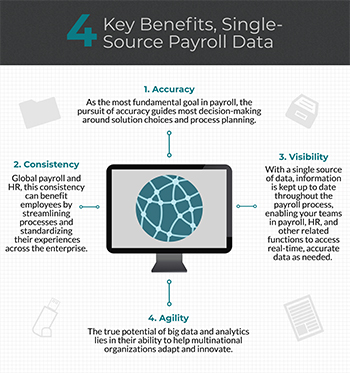
The unprecedented volume of data produced, collected, shared, and stored on a daily basis has become a hallmark of the modern working world. Amid growing demands for data protection and transparency, and evolving regulatory requirements like the incoming General Data Protection Regulation (GDPR) in the European Union, it is clear to both companies and consumers that our masses of data require the best management methods available. However, that’s only the first step.
The challenge to businesses today is how to use that carefully managed, tracked, and protected data to benefit internal processes and overall performance. Luckily, the solution lies in the same technology that enables better information management: a single source of data. Rather than maintaining versions of the same data in separate systems, forward-looking organizations are integrating core business systems and maintaining a single source of information used seamlessly across the enterprise.
This single source of truth ensures that related functions are using the identical information at all times, and this provides numerous additional benefits. By adopting single-source, data-driven solutions, organizations can address internal needs, compliance requirements, and a range of other goals. Below are four key benefits to single-source payroll data:
1. Accuracy
As the most fundamental goal in payroll, the pursuit of accuracy guides most decision-making around solution choices and process planning. However, the majority of multinational organizations maintain data in disparate systems and then transfer information to and from functions as needed. This method creates multiple versions and the possibility for data to be changed or corrupted.
In contrast, a single data source enables all departments to use the exact same, most current information. Because the data is integrated directly into whichever system is being used—whether for payroll, HCM, finance, or another function—there is no need for manual handling of the data
and, therefore, no opportunity for error. The result is greater precision with less effort, a clear benefit for teams working with challenging data sets like payroll that can change regularly.
2. Consistency
The maintenance of a single source requires that data must be standardized, meaning it is collected in the same format according to the same procedures. Particularly for global payroll and HR, this consistency can benefit employees by streamlining processes and standardizing their experiences across the enterprise. Additionally, a single source of data helps ensure consistency in reporting and calculations, which benefits payroll and overall compliance efforts. A single source of data is part of a defensive data strategy, which includes protection protocols and workflows concerned with keeping data secure. Consistency in data format and management is central to these security efforts—and becomes automatic when maintaining a single data source.
3. Visibility
The ability to see precisely what is happening within your organization at any given time is invaluable when it comes to analyzing performance and improving processes. Reviewing outcomes and exception reports after the fact just doesn’t cut it. With a single source of data, information is kept up to date throughout the payroll process, enabling your teams in payroll, HR, and other related functions to access real-time, accurate data as needed.
Greater visibility means issues can be identified and addressed before they affect payroll outcomes, and advanced analytics can reveal opportunities for process improvement that could be missed by looking only at end reports.
4. Agility
The true potential of big data and analytics lies in their ability to help multinational organizations adapt and innovate. The accuracy, consistency, and visibility provided by single-source, data-driven payroll enables business leaders to look strategically at the future, make better-informed decisions, and understand the impacts of changes in payroll as well as elsewhere in the organization. Because single-source data requires integration with related functions, such as HR, finance, or accounting, companies that adopt this strategy benefit from having a more complete picture to look at when evaluating options for expansion or workforce planning.
The Big Picture
By integrating data-heavy functions and creating a single source of information on which those teams as well as company executives can rely, global organizations can set themselves up for a more informed, agile future. While the costs of integration are dropping, the ease and availability of integrated solutions are improving—making now an excellent time to explore your options.
The new normal of integrated data and functions is now commonplace, and it’s time for that reality to include payroll, arguably your largest source of workforce data and the one that is updated with every pay cycle. Only by integrating your payroll function can you see the big picture, which is ultimately the best source of truth you can have.
 Paul Bartlett is the CEO of CloudPay, a managed global payroll and payments solution for multinational organizations. A global business expert, Bartlett has deep experience helping companies improve the efficiency and scalability of their operations using technology and services. As CloudPay’s CEO, Bartlett spearheads corporate innovation and product development initiatives focused on automating client workflows and minimizing manual practices. Throughout his career, Bartlett has helped organizations address strategic and operational challenges as they navigated different growth phases and scaled their operations. In addition to CloudPay, Bartlett has served as a partner of Rho Ventures since 2007, focusing on investments in SaaS, software-related services, and new media.
Paul Bartlett is the CEO of CloudPay, a managed global payroll and payments solution for multinational organizations. A global business expert, Bartlett has deep experience helping companies improve the efficiency and scalability of their operations using technology and services. As CloudPay’s CEO, Bartlett spearheads corporate innovation and product development initiatives focused on automating client workflows and minimizing manual practices. Throughout his career, Bartlett has helped organizations address strategic and operational challenges as they navigated different growth phases and scaled their operations. In addition to CloudPay, Bartlett has served as a partner of Rho Ventures since 2007, focusing on investments in SaaS, software-related services, and new media.